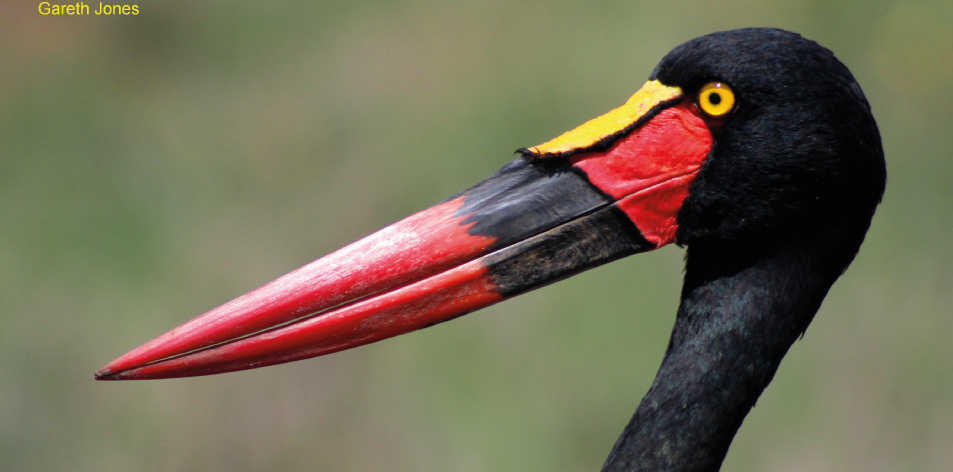
The Thrill Bills!!!- Article by Gareth Jones
The Thrill Bills Of The Nairobi National Park
As I approached a dam in the forest near the Langata gate, a flash of colour caught my eye, there in the midst of the reeds was a magnificent saddle-billed stork. I sat quietly and watched for a while. It was obvious that this stork was trying to hunt in the late afternoon. Many storks including saddle-billed use their necks as a kind of wound up whiplash as they coil their necks up, then at the appropriate time release in the rapid elastic-like action that often results in prey like fish and other aquatic creatures being impaled on their lethal bill. Suddenly the stork lunged forward and emerged from the reeds with a frog, then in one open billed action gulp, it was “goodbye freddy”.
On another occasion, as I approached the stream crossing the area, a flash of colour caught my eye, there next to a small bush were two magnificent saddlebill storks. They were undoubtedly on “honeymoon” and the male was flapping his wings and really trying to show off to this “lady”, but the female in typical fashion showed very little interest and kept aloof, as she waited for the male to seemingly impress her. Eventually, the female flew off and the male eagerly followed her, hopefully, the “stork honeymoon” helped to increase their population.
Watching a saddle-billed stork bathing itself is quite interesting to watch and is something that few people have ever seen. Late one afternoon, I rounded a corner and found a saddle-billed stork very close to the road, about to bathe in a deep pond. The stork slowly sank deep into the water, and then while maintaining depth flapped its wings rapidly, this action resulted in the shower of water that seemingly cleaned the bird. This “sink and flap” action of bathing was done repeatedly for a few minutes. Eventually, the supposedly clean stork (are muddy ponds clean ?) emerged from the water and stood on the bank flapping its wings widely and then holding its wings wide open to accelerate the drying process.
To actually see a saddlebill in the wild is always a thrill as they are large, impressive and colourful. In many parts of Africa these storks are very rare, so to actually have them in the Nairobi National Park is wonderful. However, to me, these storks are much more than mere Saddle-billed storks. I sometimes also refer to them as the “Thrill-bill” storks due to their incredible bills. they are not just beautiful in striking colours but are formidable in size as well. The massive bill (up to 36cm long) is red with a black band and a yellow frontal shield (the “saddle”). It is useful to note that the males have yellow wattles just below their bills and red-brown eyes, while the females have no wattles and yellow eyes. Saddle-billed storks are big birds that grow to a height of about 150cm, a length of 142cm and can have a 2.4–2.7m wingspan. The male is larger and heavier than the female, weighing anywhere from 5.1–7.52kg. The female will weigh between 5 and 6.84kg. At almost five feet tall, this stork is the tallest stork species in the world.
They are silent except for the bill-clacking noise they make at their nests. The saddle-billed stork doesn’t have a syrinx, which is the vocal organ of birds. The syrinx is the vibrating cavity found in the breasts of many birds which allow them to trill, warble, whistle or sing. Because storks don’t have a syrinx, chicks make hissing sounds when wanting their parents’ attention, but in adulthood they are mute.
The saddle-billed stork has a diet based on fish, crustaceans (crabs, shrimps), and amphibians (frogs). But they will also eat small reptiles (lizards, salamanders), molluscs, bird eggs, small mammals, and large water-beetles. Because the storks will use their beaks to stir up the water to flush out the fish, this causes the water to become muddy as well as the fish so they often wash their fish before consuming them whole.
I know of some people that visit the park for the prime purpose of going on a “birding safari”, there are so many hundreds of species to see at all times of the year. It is good to stop at a rest site or just switch off the car engine and listen to the incredible variety of bird songs that God has created, it is very calming and helps relieve stress. So next time you visit the Nairobi National Park be on the look-out, you never know, you may have a “thrill-bill” sighting.


